Switching the language in the Android application

There is an easy way to implement language switching in a Single-Activity application. The stack of screens in this approach is not reset, the user remains where he switched the language. When the user goes to previous screens, they are immediately displayed translated. And the result of the localization of numbers, sums of money and interest may surprise designers.

What will be discussed, and what will not be discussed?
Further there will be nothing about:
- The theory that underlies the formatted output of strings, and the implementation details of the libraries that deal with this. That is, what would help you write your library.
- Resources string, vector and others. About which resource qualifiers to use, which pictures in Arabic should be displayed from right to left, and which not, and other subtleties.
- The process of centralized translation of resources for all platforms. How to organize it so that everyone lives well, even iOS nicknames.
And we will talk about:
- Practice. Consider the problem, its limitations and solution with diagrams, examples, and code fragments.
- The SDK API that was used for this solution.
- Features of the formatting of numerical values for different regional standards, which designers should know about.
What do we want to do?
Let there be a screen with settings in our application, and we want to add a couple of new items to it, one of which would allow you to switch the language of the application, and the other to change the currency in which the money amounts are displayed. Here are some examples of how this might look.

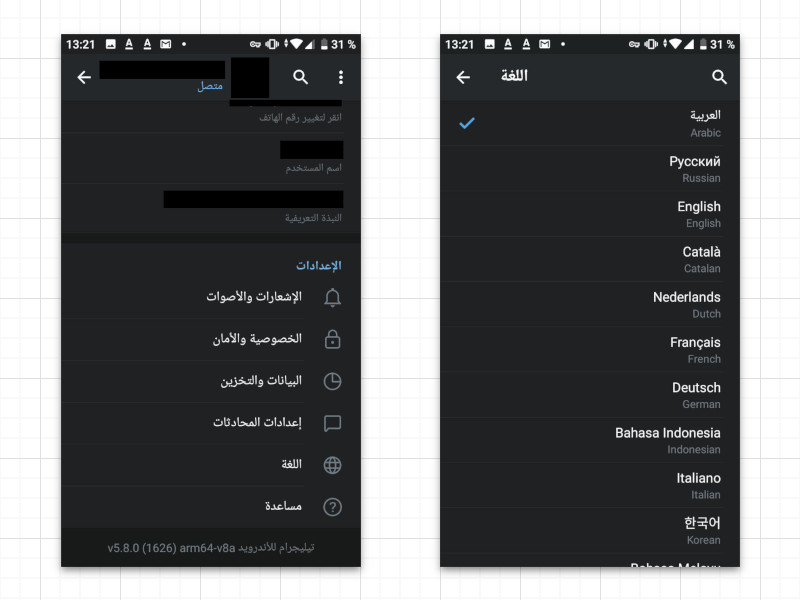
In addition to translating the text and displaying the layout from right to left, these settings should affect the format for displaying numerical values. It is necessary that everything is displayed according to the selected locale.

Architectural solution
Imagine that our application is written in accordance with the Single-Activity approach . Then the language switching mechanism can be implemented as follows.
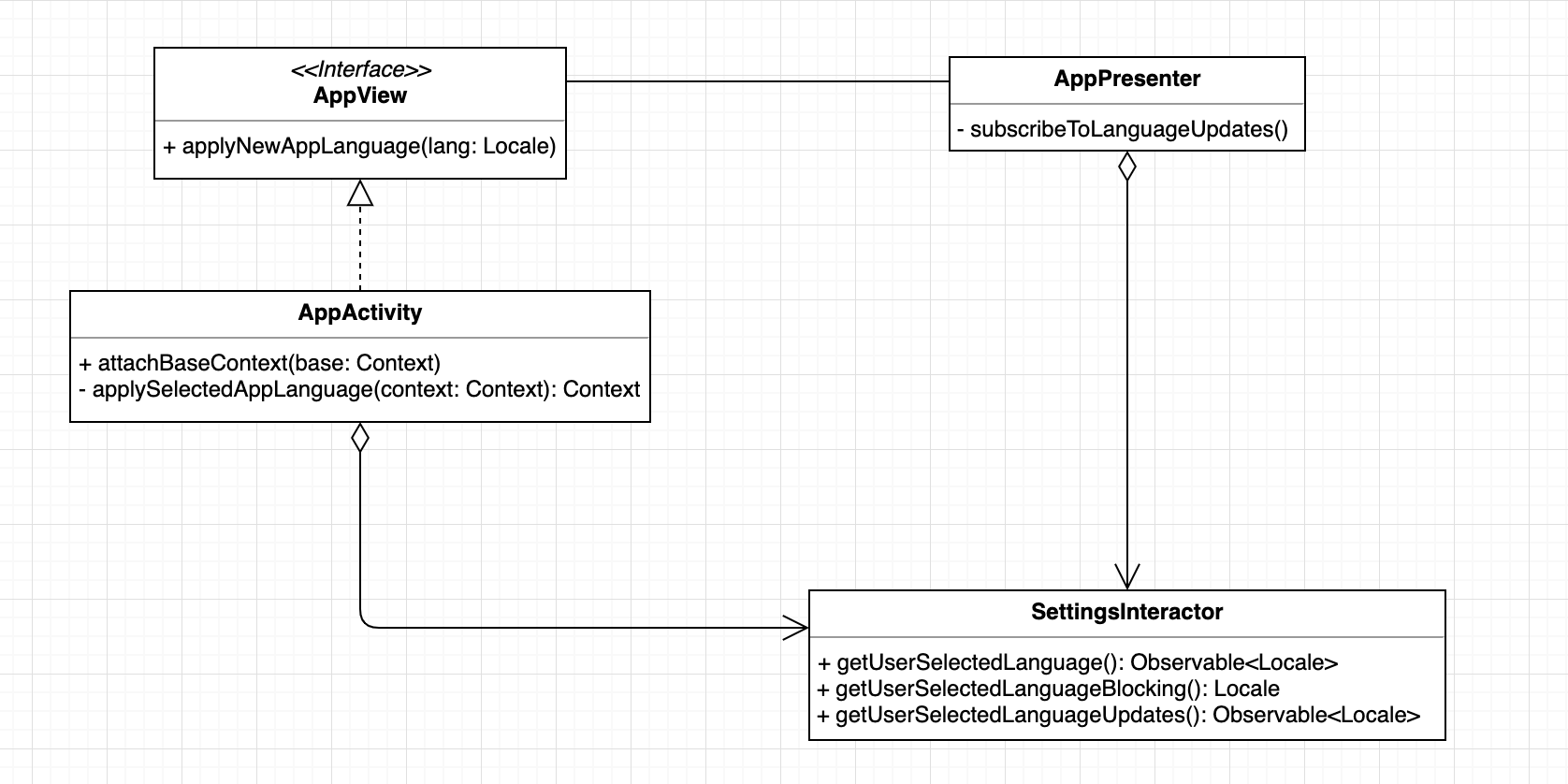
SettingsInteractor is the source of the current language value. It allows you to subscribe to this value, receive it synchronously and only subscribe to updates. If necessary, you can introduce an additional abstraction over SettingsInteractor according to the principle of interface separation . In the diagram, irrelevant details are omitted.
AppActivity at creation replaces the context with a new one so that the application uses resources for the selected language.
override fun attachBaseContext(base: Context) { super.attachBaseContext(applySelectedAppLanguage(base)) } private fun applySelectedAppLanguage(context: Context): Context { val locale = settingsInteractor.getUserSelectedLanguageBlocking() val newConfig = Configuration(context.resources.configuration) Locale.setDefault(locale) newConfig.setLocale(locale) return context.createConfigurationContext(newConfig) } AppPresenter in turn, subscribes to language updates and notifies View of the changes.
override fun onFirstViewAttach() { super.onFirstViewAttach() subscribeToLanguageUpdates() } private fun subscribeToLanguageUpdates() { settingsInteractor .getUserSelectedLanguageUpdates() .subscribe( { newLang -> viewState.applyNewAppLanguage(newLang) }, { error -> errorHandler.handle(error) } ) .disposeOnDestroy() } AppActivity re-created when a notification of a language change is received.
override fun applyNewAppLanguage(lang: Locale) = recreate() 
AppActivity is the only one in the application. All other screens are implemented in fragments. Therefore, when recreating the activity, the stack of screens is saved by the system. If you return to previous screens, they will be reinitialized and displayed translated. The user will remain on the language selection list and see the result of his choice instantly.
Formatting numbers, cash, and interest
In addition to replacing the context, it is necessary to format the data - numbers, money, interest. Let each View delegate this task to a separate component, let's call it UiLocalizer .

UiLocalizer uses the appropriate NumberFormat instances to convert a number to a string.
private var numberFormat = NumberFormat.getNumberInstance(lang) private var percentFormat = NumberFormat.getPercentInstance(lang) private fun getNumberFormatForCurrency(currency: Currency) = NumberFormat .getCurrencyInstance(lang) .also { it.currency = currency } Please note that the currency must be set separately.
If you save CPU cycles and bits of memory, and switching currency and language is the main and often used function of your application, then, of course, you need a cache.
Representation of languages and currencies
Instances of the Locale class are created by a language tag , which consists of a two-letter language code and a two-letter region code. And instances of the Currency class are based on a three-letter ISO code . In this form, the language and currency must be serialized to save to disk or transfer over the network, and then it will be good. Here are some examples.
// IETF BCP 47 language tag string. private val langs = arrayOf( Locale.forLanguageTag("ru-RU"), Locale.forLanguageTag("en-US"), Locale.forLanguageTag("en-GB"), Locale.forLanguageTag("he-IL"), Locale.forLanguageTag("ar-SA"), Locale.forLanguageTag("ar-AE"), Locale.forLanguageTag("fr-FR"), Locale.forLanguageTag("fr-CH"), Locale.forLanguageTag("de-DE"), Locale.forLanguageTag("de-CH"), Locale.forLanguageTag("da-DK") ) // ISO 4217 code of the currency. private val currencies = arrayListOf( Currency.getInstance("RUB"), Currency.getInstance("USD"), Currency.getInstance("GBP"), Currency.getInstance("ILS"), Currency.getInstance("SAR"), Currency.getInstance("AED"), Currency.getInstance("EUR"), Currency.getInstance("CHF"), Currency.getInstance("DKK") ) Features for formatting numeric values
The result of formatting numbers in accordance with regional standards may differ from what was expected. The currency symbol or its three-letter code in different languages will be displayed in different ways. Minus signs of negative monetary values will appear in unexpected places, and in some places brackets will be displayed instead. The percent sign may not be exactly the sign we are used to.
The fact is that, from the point of view of regional patterns, the final line consists of a prefix and suffix for positive and negative numbers, a thousand separator and a decimal separator, and they are different for different locales.
The numbers
| Language | Negative Prefix | Negative Suffix | Positive Prefix | Positive suffix | Grouping sepaarator | Decimal separator |
|---|---|---|---|---|---|---|
| ru-RU | "-" | "" | "," | |||
| en-US | "-" | "," | "." | |||
| iw-IL | "-" | "," | "." | |||
| ar-AE | "-" | "٬" | "٫" | |||
| fr-FR | "-" | "" | "," | |||
| de-de | "-" | "." | "," | |||
| de-CH | "-" | "'" | "." | |||
| da-dk | "-" | "." | "," |
Currencies
| Language | Negative Prefix | Negative Suffix | Positive Prefix | Positive suffix | Grouping sepaarator | Decimal separator |
|---|---|---|---|---|---|---|
| ru-RU | "-" | "₽" | "₽" | "" | "," | |
| en-US | "- $" | "$" | "," | "." | ||
| iw-IL | "-" | "₪" | "₪" | "," | "." | |
| ar-AE | "-" | "د.إ." | "د.إ." | "٬" | "٫" | |
| fr-FR | "-" | "€" | "€" | "" | "," | |
| de-de | "-" | "€" | "€" | "." | "," | |
| de-CH | "CHF-" | CHF | "'" | "." | ||
| da-dk | "-" | "kr." | "kr." | "." | "," |
Interest
| Language | Negative Prefix | Negative Suffix | Positive Prefix | Positive suffix | Grouping sepaarator | Decimal separator |
|---|---|---|---|---|---|---|
| ru-RU | "-" | "%" | "%" | "" | "," | |
| en-US | "-" | "%" | "%" | "," | "." | |
| iw-IL | "-" | "%" | "%" | "," | "." | |
| ar-AE | "-" | "٪" | "٪" | "٬" | "٫" | |
| fr-FR | "-" | "%" | "%" | "" | "," | |
| de-de | "-" | "%" | "%" | "." | "," | |
| de-CH | "-" | "%" | "%" | "'" | "." | |
| da-dk | "-" | "%" | "%" | "." | "," |
Moreover, the formatting results for Android SDK and JDK may be different. Moreover, all options are correct, each of them is used in certain contexts.
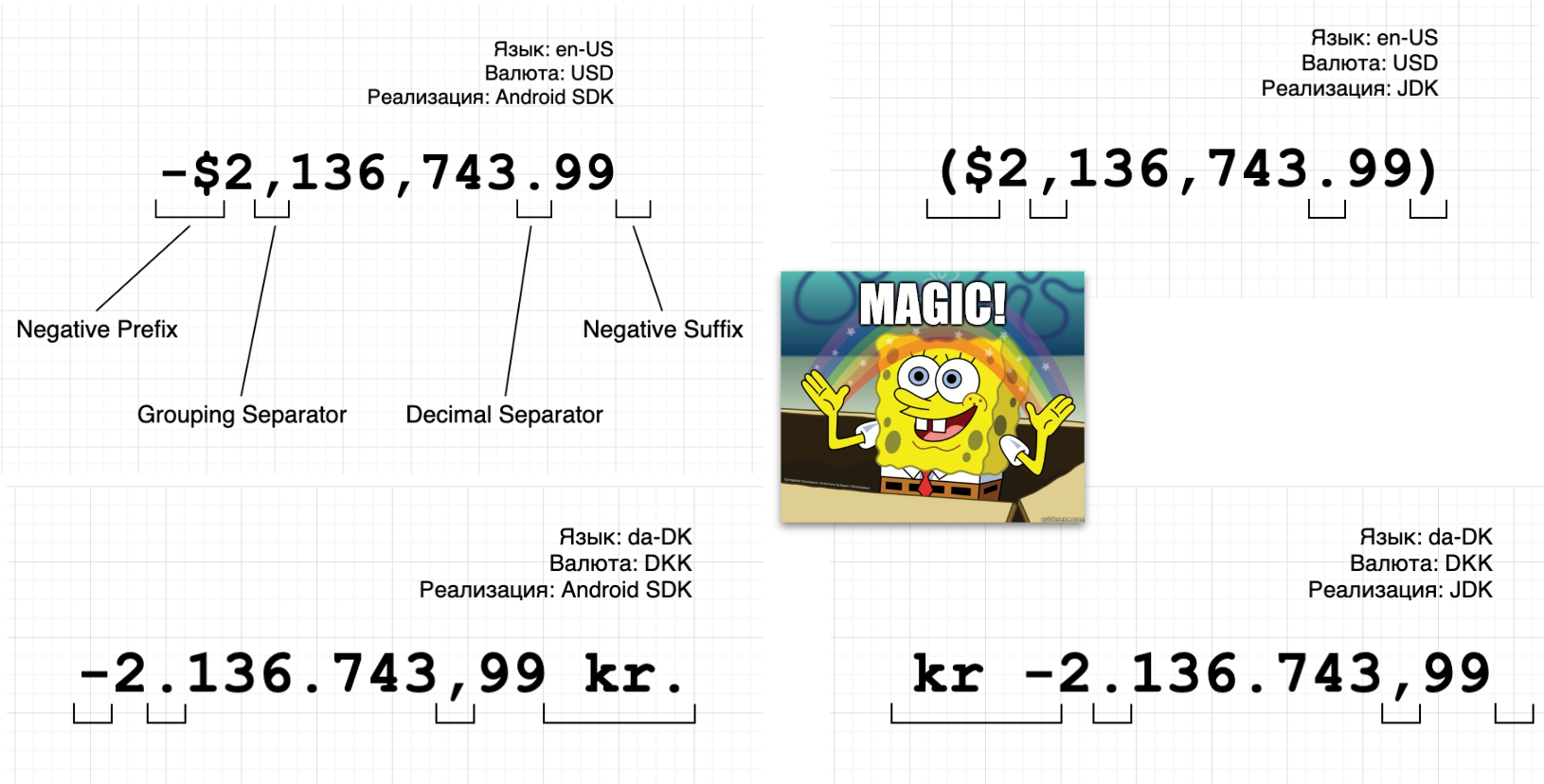
Decimalformat
When we create NumberFormat to format certain values, we get objects of the DecimalFormat class that are simply configured by different templates. By DecimalFormat object to the DecimalFormat type and using its interface, you can change parts of the template to break everything. But it is better to worship givenness.

You can also write a test to enjoy the variety. Not for all locales the same currency is displayed with a symbol.
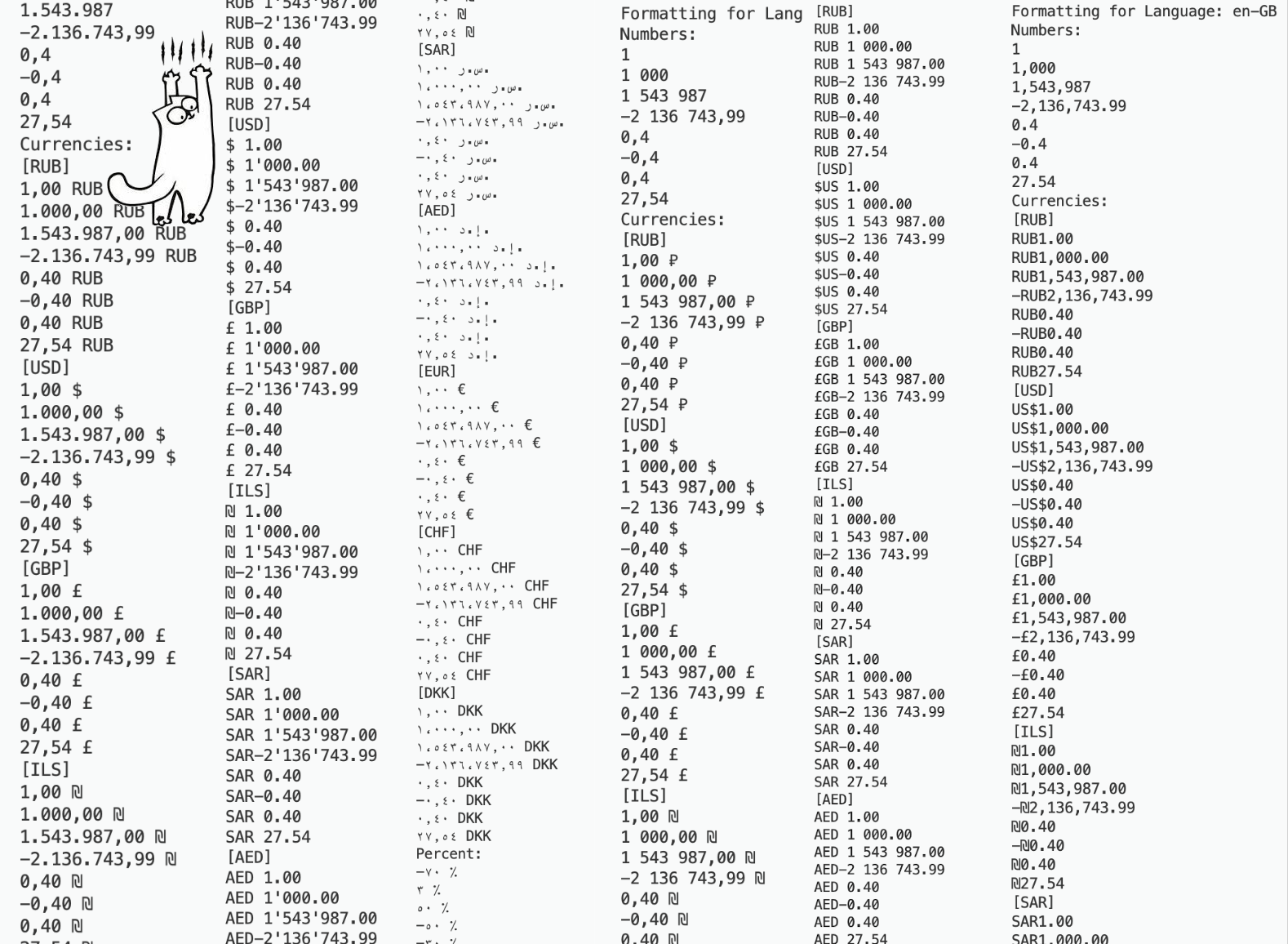
Eventually
The general scheme of the solution is as follows.

AppActivity life cycle is the life cycle of the entire application. Therefore, it is enough to recreate it to restart the entire application and apply the selected language. And since there is only one activity, it’s enough to keep the subscription for changing the language in one place - in AppPresenter .
As we saw, regional formats for outputting numbers are not trivial. You should not rigidly set a single template for all occasions. It is better to entrust the formatting of the SDK and agree that the numbers will be displayed according to the standard, and not as drawn on the layouts.
What's easier to test? (bonus)
To save time, you can use the following flag.
android { ... buildTypes { debug { pseudoLocalesEnabled true } } ... } Select the desired pseudo-locale in the phone settings.
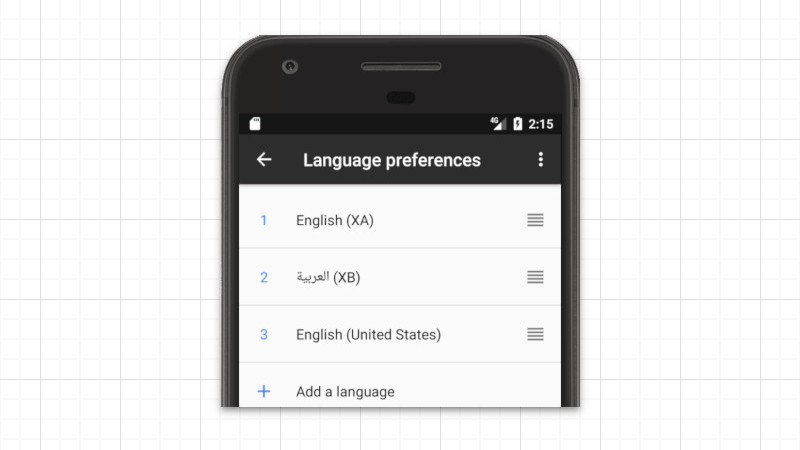
And observe how the layout goes because of the long text, and some elements of the UI stubbornly do not want to be displayed from right to left.

More information can be found in the documentation .
It is worth noting that pseudo-locales will not work if you change the context, as in the solution above. You are changing the context. Therefore, you must add en-XA and ar-XB to the language selection list inside the application.
That's all. Have a good localization and good mood!

')
Source: https://habr.com/ru/post/461085/
All Articles